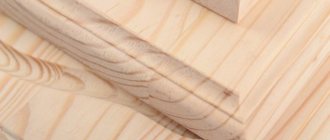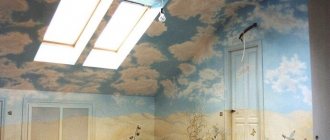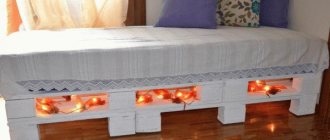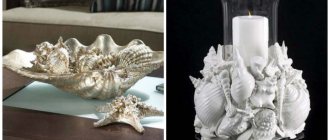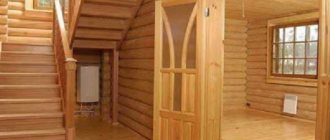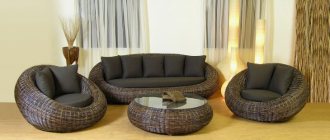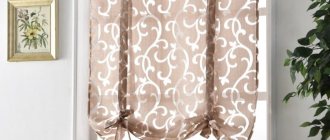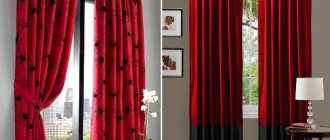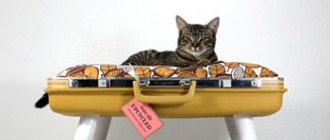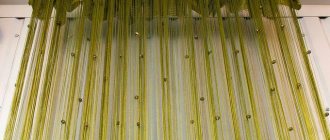Let's start with flowers. We cut out a large number of flowers from paper. To make one flower, we bend the petals of one flower, glue them onto another flower, and glue the core inside. We make the required number of such flowers. Ready-made flowers for decoration. Let's move on to creating paper butterflies. To do this, take black cardboard and cut out butterflies. The butterflies are painted with blue and cyan acrylic paint, and liquid glitter is applied to the paint. Next comes a children's plastic hanger. We tie three ropes to it.
Glue the flowers onto the hanger using a heat gun.
We place paper butterflies on strings. Butterflies are one of the best home decorations, because with their help you can create truly elegant and light accents in decorating your home or banquet hall for a children's party or wedding. In addition, butterflies can be used to make children's hairpins, etc. Therefore, I hasten to tell and show you how to make a butterfly with your own hands from different materials.
How to make a paper butterfly with your own hands
The easiest way to make butterflies is to cut out a template, trace it on colored cardboard and cut it out. Such beauties can be attached to walls, curtains, tablecloths using Chinese pins or double-sided tape, or simply strewn with them on the floor, filled with some containers, etc.
Or draw butterflies with paints and cut them out, leaving a white outline.
Or carefully cover it with cloth.
And if you have a plotter: cut patterned butterflies. By the way, you can go further and cover them with glitter varnish. The result is simply magical.
In addition, you can make origami butterflies from paper.
Lovers of everything unusual will like the idea of making “live” butterflies. These butterflies are perfect for invitations: place it in a card, envelope or box (the recipient will be very surprised when he opens the “packaging”). But first things first.
You will need: hard cardboard, wire, thin rubber bands, pliers, scissors.
The size of the wings and wire base depends on what kind of butterfly you ultimately need (you can first cut out the wings of the required size and then make a wire base using them). You will need to make two parts from the wire, as shown in the photo above. The whole chip is in elastic bands; it will need to be pulled onto a wire - connect the two parts together. Cover the wire with cardboard wings. On the finished butterfly, “rotating” the upper wings, tightly twist the elastic band and place the butterfly in a tight container. When opened, it will fly out as if alive, due to the unwinding of the elastic band. Agree on an original way to make a butterfly with your own hands.
Where to begin.
So, you have decided to opt for this relatively new direction in the world of design, decorate the wall with butterflies, add sophistication to the atmosphere of your home, fill it with light romance, dreams and winged flowers. A reasonable question arises: how to decide on the sequence of actions? Where to start the preparatory stage?
- For the place where winged residents will settle in your house (apartment), it is better to choose the most visible wall, not cluttered with furniture. Agree, if your butterflies huddle in the gap between two cabinets, the effect will not be the same.
- Think about how and where exactly the butterflies will be placed: either it will be a small area, or, on the contrary, the butterflies will occupy the entire surface. Perhaps in your case it will be appropriate not only to mount butterflies on the wall, but also to decorate additional places: a special frame, hanging from a chandelier, sconce, or you decide to make a special panel.
- An important and even more decisive factor will be what you decide to make butterflies from. It is important that the material you use matches the interior of the room. Below are various ideas for creating moths: from traditional to unexpected solutions.
- Color combination. Decide what you want to get in the end: either butterflies will become a bright accent on a light wall, or your moths will be in calm bed colors, complementing the overall color scheme of the room, giving it dynamism.
- Size and shape. You can opt for large specimens of representatives of the flying fauna or make many small bright butterflies, or a combination of different sizes will suit you. Do not try to make the wings strictly symmetrical - this way you can get a strong artificial effect. Asymmetry prevails in nature. To give volume and dynamism to the application, you should not adhere to specularity.
- Check that you have all the necessary tools and materials that will be useful to you in the future. It will be a shame to be distracted from the creative process in the midst of it if it suddenly turns out that you do not have enough necessary things.
- You need to determine how much time you are willing to spend on making wall decor and take into account that elements that are too complex will take a longer time.
- To make butterfly blanks, we recommend making a stencil. If you are going to draw each butterfly individually, it will take too much time. If you want to diversify the look of the blanks as much as possible, you can make several stencils.
You can use ready-made templates for cutting, programs that edit drawings.
How to make butterflies using the pargament technique with your own hands - master class
Unfortunately, not many people know the parchment technique, but, in my opinion, it is more suitable than any other for creating incredibly beautiful butterflies. Especially for you, we tell you and show you not only how to make pargament butterflies, but also how to do without buying special tools for pargament.
Let's start with the tools:
- the most basic thing is parchment paper (thick waxed tracing paper, density at least 150 g/m2)
- a special mat for embossing (stamping) and a mat for perforating (piercing). Special rubberized mats for pargamano are sold, but it can be replaced with a regular computer mouse pad.
- Dots (used for embossing) are pens with balls of different diameters at the ends. Dots can be replaced with knitting needles, crochet crochet, or a non-writing ballpoint pen.
You can make dots with your own hands:
using piercing earrings with a gel pen (pull the shaft out of the gel pen, blow out the remaining gel and simply screw the earring shaft into place of the pen shaft).
from stationery clips and a pen/marker (disassemble the stationery clips - you will need metal staples, you don’t need to bite anything off of them. We simply deform the metal using pliers to the desired shape. We insert the resulting shapes into the pen/marker so that they do not dangle, you can support them with wooden skewers ).
- Snap-on pencils are used to pierce holes along the contour of a design or apply any pattern. Instead, you can use a regular needle or a thin awl.
- Small scissors (the ends should be very sharp, and the blades themselves should be narrow and thin) - you can use nail scissors that have suitable characteristics.
- Parchment board with special stencils of the desired images. If you do not plan to make pargament, you can print the desired design on paper and use a white pencil/pen/ink to transfer it to tracing paper.
- Paper tape - for attaching tracing paper to the stencil.
- Transparent ruler.
- If you decorate butterflies with beads, purchase special glue for parchment paper - it leaves no marks after drying. In addition, LEEHO glue (South Korea) is perfect.
- Half beads for decoration - optional.
Progress:
We place the stencil board on the embossing mat (step No. 2 in the photo above), place parchment paper on top and secure it with tape (the outer side of the parchment paper - which you look at after embossing - will be the wrong side. On the front side you will get a convex pattern).
And using dots of different sizes, we begin to emboss the design (No. 3). If necessary, press the tracing paper firmly onto the board using a ruler (do not touch it with your fingers) so as not to leave stains on the paper.
Next step #4 - after the embossing is completed, turn the board with the attached parchment paper over and place it on the perforation mat. And use a needle or pencil to make holes along the contour. Photo No. 5 shows the result of perforation.
For greater liveliness, you can make the butterfly two-row, so use the stencil only for the upper half of the wings (No. 6).
All that's left are the final touches: glue the parts together and glue the half-beads on top - admire the result!
In the previous case, we showed the progress of working with a stencil board. But as mentioned above, you can do without it.
Print out the desired design and use a white pencil to transfer the design onto parchment paper. And then nothing new: turn the sheet of tracing paper over to the back side and carefully trace the drawing with dots. Then we immediately carefully cut it out with scissors (you can make perforations - it depends on what kind of edges you want in the end. In general, both are beautiful in their own way). At the end, you can slightly bend the wings and also glue half beads to them.
Butterflies for decoration. Material of manufacture
Paper butterflies appeared quite recently, but have already become popular. They look beautiful in absolutely any room - in the kitchen, bedroom, hallway, nursery. Such decoration can be in a chaotic design, scattered or in a suspended state. The last option is often used for a crib.
Important! According to Feng Shui, butterflies represent a symbol of rebirth, joy and mutual love.
Materials for making moths:
- Colored paper.
- Cardboard.
- Magazines.
- Vinyl records.
- Starched fabric.
- Thin metal (tin cans).
The size of such an elegant decoration can be very different. You can often find a picture in the center of which there are large butterflies of bright color, and small beauties of a more delicate, muted color scatter around the edges. The shape and color of butterflies is as limitless as their size.
Important! Those winged with a whirlwind look very original, when a whole flock of bright beauties flies off from one butterfly. The most important thing here is to work hard on the picture you want to get in the end.
How to make a butterfly from polymer clay with your own hands
If you try, the result will exceed all expectations. By the way, you don’t need any special skills: a little accuracy and concentration and you will get a very beautiful butterfly made of polymer clay.
So, to create it you will need:
- accordingly, self-hardening polymer clay (any company - at your discretion)
- template paper
- cling film + Vaseline (hide the clay so that it does not dry out prematurely)
- rolling stack
- texture reminiscent of wings (floral mold, plant leaf, shell)
- paints (oil blue, black and white; acrylic black)
- thin wire
- scissors
- We decide on the silhouette - draw it on paper and cut out the templates (we need 4 wings).
- Take a small piece of clay and mix blue oil paint into it. From the resulting blue clay we tear off a piece the size of a pea (we put the rest of the clay in cling film greased with Vaseline so that the clay does not harden). Roll out a piece of clay into a thin layer in the palm of your hand.
- Next, we simply apply the wing template to this layer, press it tightly and immediately remove it (the outline should remain). We take scissors and carefully cut out the contour, place it again on the palm and thin it with a stack and roll out the edges. And we transfer the wing to some surface to add texture (in this case, a floral mold was used).
- We glue a thin wire to the textured wing using PVA glue and lay the wing to dry on an uneven surface, giving it a shape. We do the same step by step with the remaining 3 wings.
- Next you need to make a body: mix black oil paint into the remaining blue clay and mix thoroughly. Then we make an elongated “drop” from the resulting black clay. We form a head on it and use thread or wire to make longitudinal stripes. Leave the body to dry.
- While the body parts are drying, work on the antennae. Bend small loops on two pieces of wire and paint them with black acrylic paint. Give them time to dry too.
- Completely dried wings must be additionally painted. First, we tint the entire wing with white oil paint: you need to work with a wide, semi-dry brush (you don’t need to “paint over” the whole thing, you need to slightly emphasize the texture). Next, using black oil paint from the edge to the center, draw the veins and paint over the edges. We cut off the excess wire from the finished wings, (8) make punctures on the body and glue the wings with good super glue. Glue the antennae in the same way.
That's it, the polymer clay butterfly is ready!
You can change the color, and even the shape itself, make it double, with patterns, press beads into polymer clay that has not yet dried, decorate the finished butterfly with feathers, etc. - it all depends on your design idea. Go for it!
Fastening methods.
Glue. If you don’t care whether traces remain after you want to remove the butterflies, you can use different types of glue (PVA, glue stick, wallpaper glue, etc.). The main thing is that the glue fulfills its function and holds the decor on the wall. It is worth noting that it is better not to glue butterflies completely to the wall, but to create so-called volumetric applications, which will create a natural effect. For volume, butterflies need to bend the wings and glue only the middle with a small amount of glue. Subsequently, the curved wings will “flutter” from any air flow.
Styrofoam. Small pieces of foam are used to attach small, lightweight butterflies. First we glue the foam to the figure, and then to the wall.
Double-sided foam tape is also successfully used for fastening.
Fastening with pins. If you need to maintain the integrity and original appearance of the wallpaper, then pin fastening is suitable for this. This method is not suitable for plastered walls. The pins are bent with pliers at an angle of 90. After securing the upper part to the body of the butterfly with glue, the end is carefully placed behind the wallpaper. If necessary, the decor can be easily dismantled without leaving marks on the wall.
Important! Cardboard “individuals” have more mass than paper ones, which must be taken into account when attaching.
How to make a butterfly from satin ribbons using the kanzashi technique with your own hands
First, we present to your attention a master class on “how to make kanzashi petals.”
Kanzashi petals: sharp and round
So, see below how to make a butterfly from satin ribbons using the kanzashi technique.
We start with the top wings.
You will need: two types of ribbon 5 cm wide, 10 cm long (in two copies), a ribbon of a different color 5 cm long and wide (two squares) and a couple more squares measuring 2.5 cm.
- We take the two largest pieces of multi-colored ribbons, put them together and wrap them in an airplane (triangle).
- We carefully pierce it with a needle from below; in addition, you can glue a rhinestone above the needle at the seam junction (photo No. 2) or hold it with your finger so that the seam does not diverge.
- Next, fold our “triangle” in half and fix it with a clamp as shown in photo No. 3, cut off the excess (cut line No. 1). To make both wings the same, apply them to each other.
- Then we cut off the excess along line No. 2. We singe the edges of the cut from line No. 1 together, and on the second side, each side separately.
- Next, we make round “petals” with folds so that small sharp petals fit into them.
- We carefully first glue the small sharp petals between the folds of the round petals, then glue them into the large sharp petals. We make the lower wings simply round; you can glue rhinestones on them.
- We fold all the wings and stitch them with a large needle and long thread (try to capture all layers of ribbons). We tighten the threads well and tie them, trim off the excess threads. From below, at the junction of all the wings, we drip glue and align them so that they are all on the same level.
- We make a body from beads and seed beads. We glue the body of the butterfly and stitch it with thread.
- We assemble a circle from a piece of lace so that there is no hole left, straighten the folds evenly and glue a butterfly made of ribbons to the lace (the resulting beauty needs to be glued to a clip or simply to a round piece of cardboard covered with fabric, etc.).
Combine different ribbons with each other, as shown in the example below. Show your imagination!
Or this option:
- Cut out two squares for the wings from the ribbons.
- Lubricate the square with glue from the wrong side (you can use glue for ceiling tiles from a hardware store, for example “Dragon”) and carefully glue it into a triangle.
- Fold the resulting triangle in half and turn in the resulting corner (as shown in photo No. 3).
- We do the same with the second square of the tape. As a result, you should have two wings, as in photo No. 4.
- Next, if desired, you can give some shape to the wings. We cut out a recess at the fold. But that’s not all: with the help of a lighter you can melt the edges (To prevent the tape from burning, namely “melting”, you need to hold the tape at the bottom of the fire).
- You can make a beautiful body from beads and fishing line. As an option: we put one bead on the fishing line, combine the ends of the fishing line and string beads on them, secure with glue. Dip the ends of the fishing line into glue and glitter.
- For the base of the body, cut out a cardboard square and cover it with a piece of tape, and glue the body of beads on top.
- Glue the wings and decorate them with sequins.
You can diversify this idea. For example, take ribbons of different colors, cut out triangles, align them with the front side and fuse them with a lighter (you should get a square). Further progress is the same as with a regular square. Using this principle, you can combine ribbon with lace, etc.
No less beautiful butterflies are obtained exclusively from dense ribbons. You can decorate a postcard with these butterflies or use them in some other way - at your discretion.
Combine multi-colored ribbons with each other.
And by the way, don’t forget that you can sew butterflies from ribbons:
Butterflies on the wall - decor in the form of a painting
A panel with bright butterflies flying in different directions looks no less impressive. To implement this idea you will need:
- Glossy magazine.
- Picture frame.
- Several stencils of different sizes.
- Scotch.
- Scissors.
Instructions:
- First, we disassemble the magazine into individual pages. Cut the colored pages into squares equal to the size of the butterflies. We attach the blanks to them, and then cut out the winged insects.
Important! One important rule should be taken into account: the number of moths should be such that they fill the center of the panel, but are not located on top of each other.
- We prepare a thick sheet of paper (you can take Whatman paper), which will become the basis of our photo frame.
- Using double-sided tape, glue the moths to a white sheet. We make sure that the insects do not completely adhere to the canvas, but seem to rise above it. To achieve a volumetric effect, insert a small piece of foam rubber between the tape.
- Insert the decorated sheet into the photo frame.
The picture of colorful butterflies is ready!
Important! The picture will turn out more beautiful if you use the shading of the flying moths. Such a work of art will look more harmonious.
How to make a butterfly from “gelatinized” material with your own hands
Butterfly made of gelatin fabric. In this case, first of all you need to make a “gelatin” fabric, for this: 1 tsp. pour gelatin with cold water (1/4 cup) and let it brew for 30-40 minutes. Then (when the gelatin swells) place the container with gelatin in a steam bath and add another 1/4 cup of water. Bring the solution until the lumps are completely dissolved. Soak a cloth in it and hang it to dry without wrung out. In addition, you will need: a bun - a knife (butter knife), crepe paper, wire, glue. Additional elements are up to you: for the antennae you can use a hairpin, wire, or make them from fishing line with beads, make the body from beads, etc.
The process is quite simple:
- Make wing templates out of paper, transfer them to fabric and cut them out.
- Next, you need to process the fabric: the knife needs to be heated, directly in the flame on a gas stove (about 10 seconds). Then, before you start working on the wings, check on an unwanted piece of fabric to see if the knife is melting the fabric and start processing. We process the fabric from the inside out, hold the knife at an angle of 45 degrees and at a distance of 2-3 mm from the edge, walk along all the edges and make veins (photo No. 2 shows the grain and the knife).
- We coat a piece of wire with glue and wrap it in a spiral with crepe paper as shown in photo No. 3 (these are the so-called “letons/litons”). We make 4 of these litons.
- We glue one leton on each wing (in the veins).
- We make the mustache and body - everything here depends solely on your imagination. Photo No. 5 shows a version of the antennae twisted from a hairpin (on a knitting needle), painted on top with gold paint. And the body is woven according to a pattern of beads. Glue the antennae to the finished body. We twist the wires of the upper and lower wings together first, then we intertwine all 4 wires together, cutting off the excess.
- Using silicone glue we glue the body.
In a similar way (using hot tools) you can make a multi-layered/voluminous butterfly: for example, use satin for the outer wings, and a veil for the inner wings (by the way, in this case there is no need to “gelatinize” the fabric).
As a result, you need to cut out 2 large and two small wings from the satin (we cut holes in them). For the lower layers of the wings, cut out 4 large and 4 small pieces from the veil (no holes are needed for them).
We process them as shown in the diagram presented above in the upper right corner, glue letons to them, and let them dry. We make a body with antennae and assemble a butterfly.
How to make butterflies from threads with your own hands
Even a child can make a butterfly from threads. You can put a butterfly pattern under the cling film and lay threads dipped in glue within its outline (try to lay the threads in beautiful curls). When you have done it, set it aside, in your opinion, a sufficient number of turns of thread until the glue dries completely. In the meantime, you can make the body of a butterfly from beads. Then glue the bodies to the dried wings and use this delicate butterfly in decoration.
In general, experiment!
There are many ways to make a paper butterfly. Their diversity allows you to create a unique and stylish home interior with your own hands. For example, you can decorate a wall in your bedroom or living room in this way. The technique involves not only the use of paper, but also felt, vinyl records, cardboard, silk, organza, papier-mâché and other materials.
The advantages of paper work are simplicity and speed of execution. This material is much easier to work with than vinyl, felt and other materials. Origami also has techniques for making butterflies that can be hung on the wall. If you have long dreamed of enlivening your interior, adding notes of romance, spring and sunny mood to it, then make wonderful butterflies from plain paper with your own hands.
This activity will not take you much time, but will bring a lot of positive emotions. And the result will please not only you, but also the guests of your home.
Purpose and color
Before you start making butterflies, you need to decide what such handmade items will be used for. You can attach them to the wall in a specific order to create a beautiful composition. But there are other options. For example, you can decorate flowerpots with indoor plants in this way, or glue butterflies to furniture, for example, to a closet. The room will take on an interesting look if you attach a voluminous butterfly to a curtain or curtain, adding the colors of nature to the interior.
Once you have come up with the concept, you should decide what color your products will be. We recommend using delicate, pastel or bright shades. There are methods that will allow you to make a butterfly from colored plain or multi-colored paper. To make crafts using the origami technique, you need to use special types of paper that make it easy to make paper figures.
Decorations
To make a beautiful decoration, you need not only to choose the right paper color, but also to think about how you will decorate the product.
It is best to do this with beads or sequins, which are extremely easy to work with. They can be attached to the craft using regular glue or sewn with thread. Beads and sequins look very delicate. In addition, it is possible to choose different colors. On sale you can find mother-of-pearl beads, shiny sequins and many different decorations.
If you are going to decorate flowerpots with paper butterflies, then you need to provide for fastening. It is convenient to glue the product onto a stick, which can easily be inserted into a pot of soil.
Tools for work
Depending on what equipment you use, you will need to purchase tools and materials. The origami technique only requires special colored or white paper. The rest is done by hand. Before you start making beautiful butterflies, you need to stock up on the following materials:
- different types of paper;
- transparent glue;
- scissors;
- beads, sequins for decoration;
- markers or paints;
- wire for fixation;
- threads
After all the elements are prepared, you can begin making butterflies. Any handicraft requires inspiration and a good mood. Anyone can create beautiful crafts with their own hands. The main desire. But you can’t do it without knowledge of technology either.
Butterfly decorations
This type of decor involves applying their drawings to the walls. They can be either drawn by hand or printed using special blanks and then cut out. In fact, there are many ways to make and attach them. We will tell you about the main ones below.
Thanks to the lighting and free mounting, a beautiful three-dimensional effect is achieved
It turns out especially beautiful if the butterflies are of different sizes and are not placed chaotically, but in the form of some kind of pattern, or are used to zone one specific place. In the video you can see examples of using butterflies in the interior:
Origami technique
Origami is always made from square shaped paper.
You need to fold the square diagonally twice. After that it needs to be deployed. You will see clear fold lines. Then you need to fold the paper in half vertically and horizontally. Anyone familiar with the origami technique knows that this is how the production of all figures begins. After this, the figure folds into a triangle, the sides of which can be easily bent. To do this, connect the opposite sides of a sheet of paper. A similar double triangle is often used in origami techniques.
Let's start working with the triangle. It is necessary to alternately bend the corners to the top on one of the sides of the triangle. After this, you should bend the side that is next to the folded corners. There is only one step left to complete - straighten the wings. As you can see, it’s quite easy to make a figurine with your own hands using the origami technique. We recommend watching the detailed video instructions if you do not quite understand any of the points.
These butterflies will look wonderful if you hang them on the wall. You can arrange them in a wedge, cascade, or in a chaotic manner. They bring a feeling of lightness and romanticism to the interior of the house. True, there are not many options for their decor. Apart from decorating with beads and sequins, it is difficult to come up with other options. Such butterflies will perfectly decorate the wall in a room where the renovation is done in a minimalist style.
Cardboard.
Cardboard is a stronger material than paper, but it is also a little more difficult to work with. However, thanks to cardboard, there are more variations in shape changes. To obtain curves, you need to moisten the product and, pressing it, fix it with a weight and dry it. After which the required shape of the butterfly will remain for a long time.
Making butterflies using origami is a method that will surely delight your children, and you yourself will not leave you indifferent.
Before attaching butterflies to the wall, it is worth drawing their location on paper. Moths flying from one side of the room to the other look interesting. Turning on your imagination and harmoniously connecting your butterflies in color and texture with the overall interior is the key to success.
Using a chalk or pencil, carefully draw lines along which the butterflies will be located according to the sketch.
An easy way to make paper butterflies
The next method is more labor-intensive. But you will have the opportunity to show your artistic abilities. You need to find images of butterflies that you like on the Internet. After this, you need to print the pictures on the simplest printer. After this, you should attach the printed image to the cardboard and trace its outline. This is how a butterfly template is cut out of cardboard. You can make various templates with your own hands, which will vary in shape and size. The only rule is that the stencil must be symmetrical.
After this, you can start making paper butterflies with your own hands. It is necessary to cut out the figures using a stencil. If you want to attach them to the wall, then you should definitely make figures of different sizes. Then the composition will come out more realistic and beautiful.
After this, the most interesting process begins - decorating butterflies. Unlike the origami technique, in this case there are more opportunities to make the figurine beautiful. You can decorate it to your liking using paints or markers. Try to create a realistic color. You can even try to recreate the colors that nature has awarded to various types of living butterflies.
After you decorate the figures, you need to glue their eyes. Beads or beads of a dark color are suitable for this. If the paper butterfly is large enough, it is better to use simple black beads. As you can see, this process is very easy to do with your own hands. Then, use gentle movements to bend the wings to create a realistic look. If you want to decorate a flowerpot with flowers, then glue the finished figure onto a thin stick or wire. To attach it to the wall, just apply glue to the center of the figure.
There are many options for making butterflies. Interesting products come out of plastic bottles, nylon, organza, felt and even pages of colored magazines. A little imagination, and you will create a wonderful decoration that will become not just an attribute of your home, but also a manifestation of individuality and a creative approach to interior design.
This is a fairly simple pattern, perfect for children and adults just starting to learn origami. For this we only need:
- square sheet of origami paper.
If you take special paper, then it is most likely already square. If not, you will have to cut it out of the sheet. It is better to choose paper for crafts in the shape of a butterfly for children that is light and not too thick. And, of course, bright! All the beauty of butterflies is in the coloring of their wings.
Instructions
:
1.
Follow the simple diagram.
2.
In the eighth step, pull the corner so that the paper gathers in folds, do not smooth them out, they give the shape to the wings of our butterfly.
Multi-colored butterflies can be “seated” on a thread and hung from a chandelier, ceiling or window; they will sway beautifully with the movement of air. You can also stick origami butterflies onto wrapped gifts with double-sided tape - a great idea for congratulating friends and acquaintances who have a birthday in the warm season.
And the final master class
Another interesting example of using newsprint or pages from an old book.
You will need:
old book or newspapers;
glue;
scissors;
different frames for photographs or paintings;
White paint.
Paint the frames white (or any other color you wish). Cut out butterflies of different sizes from an old book or newspaper. Glue them together as follows: one large, one smaller and the smallest in the middle.
Arrange the butterflies in the frames.

